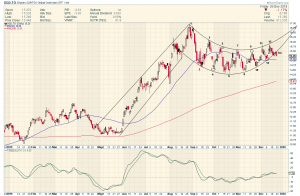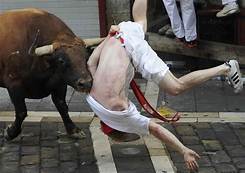XGD Bull Horn Update
I revised the pattern slightly as the top parabola actually fits right in at THE Top
(Notice the four “symmetry failures” as Rambus calls them..annotated by circles…where the reversals just fall short
two at the top line and two at the bottom…which gives validity to this strange pattern .)
This changes the number of completed reversals to unlucky 13 AND as Alpha8 noted in a comment
The pattern broke DOWN today.
The XGD.TO is the PM Miner Large Cap Canadian ETF.
Sometimes when you are running with the Bulls you get


Is the sickle or “bull-horn” an established and well-validated pattern? If not, I would like to suggest some caution in its employment — and especially around the end of the year (and decade!) with all the light volume, the options expiration, the tax and portfolio shufflings.
I don’t mean to pick just on the sickle. These comments could also be applied to the bowls used by Northstar and now Patrick, much as I am inclined to like them, unless I can be shown that they have been well validated.
Jack Schwager wrote extensively about creating and employing trading strategies. These would be ones that could actually be (if one wanted) computerized: if A and B, then do X sorts of things. You set the strategy and follow it by the precise numbers until or unless it consistently seems to stop working.
He noted that an underlying strategic consideration is that some trading strategies work well in some epochs but then give out. Therefore sometimes one has to be flexible and alter strategies. However improvising too much is no good. That’s the point I want to emphasize.
He warns that one of the many things that sinks traders is finding what looks to be a great *new* pattern (whether in numbers or in images) and thinking, “Wow! This just has to work!” and starting to trade on it because it seems so good. But it doesn’t work. It looks and seems great. But it isn’t tried and true.
Is there any solid reason to believe that the sickle would work (other than aesthetically) more than 50% of the time even if it weren’t in the waning days of the decade?
A Bullhorn is an inverted sickle.
Take your pick Karl and do take these terms literally..I made them up.
However when a pattern has this many touches / near touches I think it is valid.
“Valid” can mean many things. It is “valid” as in “cool”, “aesthetically pleasing”, “interesting”, “worth thinking about for the future”.
I use the term “valiDATED” in another sense. If I were to entrust all my money to someone and pay that person thousands of dollars per year to manage it, what criteria would I want that person to use? If I were a conscientious owner of a private company with an old fashioned pension plan, what criteria would I want the managers of the pension to use? I would want them using a systems or system that had some objective basis that had been shown to work, not simply ones that looked cool several times or that this or that person said looked nice.
I would have wanted them to have tested this sign or some other system against, for example, to see whether they found it and whether it worked in some arbitrary data set with which they were not familiar– the Canadian Pacific weeklies 1951-1957, the GB pound versus Italian lira daily 1983, copper minute to minute 3d week of July 1997, etc. If they repeatedly saw the pattern, repeatedly saw that it worked (taking into account slippage in mock trading) according to some rigorous test of statistical significance over and over again, then I would be happy for them to be using it. Otherwise they would be just playing with themselves at my expense or my employees expense. Clouds form pretty patterns. Smoke, river riplets too. Can one reliably trade on them? Perhaps by chance now and then for several times straight, and perhaps one can cite this or that authority, but I would want hard data.
A pattern might be valid as something to look at, to admire, to study for future reference as a possible useful sign, as something to gamble on. There is a different sort of validity, the one I am referring to, which is validity as a sign to rely on for major decisions for large sums that one can’t afford to lose. Perhaps this sign has a proven record. I don’t know. Or perhaps there is a proven record that unique patterns that look nice where many points fit are reliable. Again, I don’t know.
Spock has such a system .It’s his Global Matrix.
3 years running 20% per annum
Extensively backtested.
Scientifically and unemotionally created criterion
This may be the most compelling chart pattern since Schism’s Apr.2017 Martini fractals!
…which unfortunately broke DOWN for a Year-and-a-Half!
Question of the year: Will Fully’s Sickle/Bull Horn pattern usher in the next Year-and-a-Half DECLINE ??
(cue up the PT&A tune of doom: https://www.youtube.com/watch?v=7bZ4l6ow9mQ )